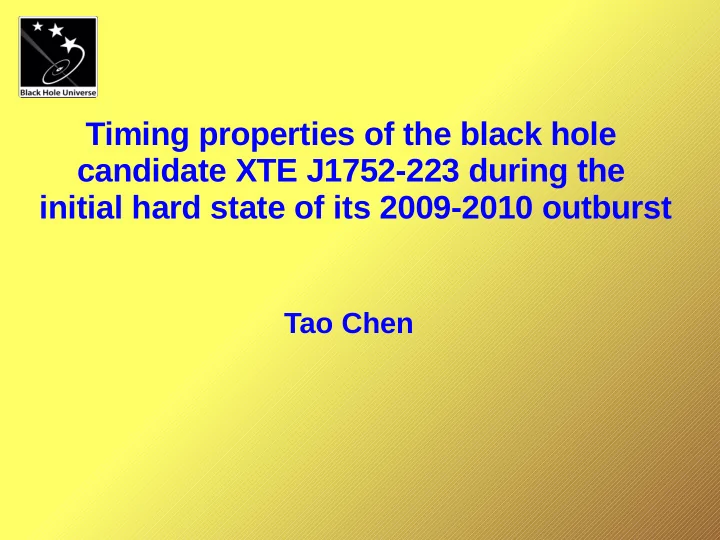

Timing properties of the black hole candidate XTE J1752-223 during the initial hard state of its 2009-2010 outburst Tao Chen
Overview ● Observation and Data Reduction ● Results ● Timing analysis ● Spectral analysis ● Connection between timing & spectral analysis ● Discussion and Conclusion ● New Data from 2010-04-03 (hard state)
On 2009-10-23 at 19:55 UT, RXTE discovered a new source while scanning the galactic bulge region, designated XTE J1752-223. Based on the existing PCA scan data, the best fit position is, R.A. = 268.05(16), Dec. = -22.31(4) (J2000). The 2-10 keV flux of the source at that time was about 30 mCrab. (1 mCrab = 2.4e-11 erg/cm/s^2, 2-10 keV)
Observation and Data Reduction Observation interval:MJD 55132 - 55155 Data format: RXTE/PCA Timing: Event and/or Binned Spectral: Standard 2 Software: HEASOFT v. 6.8 (powspec & xspec)
Timing Result Power Spectra Density were fitted by 2 Lorentzians
Power Spectrum Density of XTE J1752-223 The PDS produced for whole interval ~2000 sec., and averaged for 128 sec., with step of 0.015625 sec.
The Change of First Lorentzian's Char. Frequency The central frequency of this Lorentzian is frozen to zero
The Change of Second Lorentzian's Char. Frequency The central frequency of this Lorentzian is free
The Change of First Lorentzian's RMS
The Change of Second Lorentzian's RMS
Spectral Result Energy Spectra (2.55~45 keV) were fitted by model reflect*phabs(powerlaw+gaussian)
The Change of Photon Index and Reflection Scaling Factor
Correlation between timing and spectral Number 1 means First Lorentzian Number 2 means Second Lorentzian
Characteristic Frequency 1 & 2
RMS 1 & Photon Index
RMS 2 & Photon Index
Discussion and Conclusion ● Increasing of Photon Index (going to the IS state) ● Disk sets frequency? ● Increasing of Ch. Freq. (i.e. ● One of the Lorentzian the radius of Inner disc linked to Power Law? is increasing) ● Second Lorentzian has ● Decreasing of RMS (probably another origin. disc getting brighter) ● Cold disc (from Swift obs.)
New Data from 2010-04-03 (hard state)
PDS
The change of RMS
The change of Ch. Freq.
Recommend
More recommend